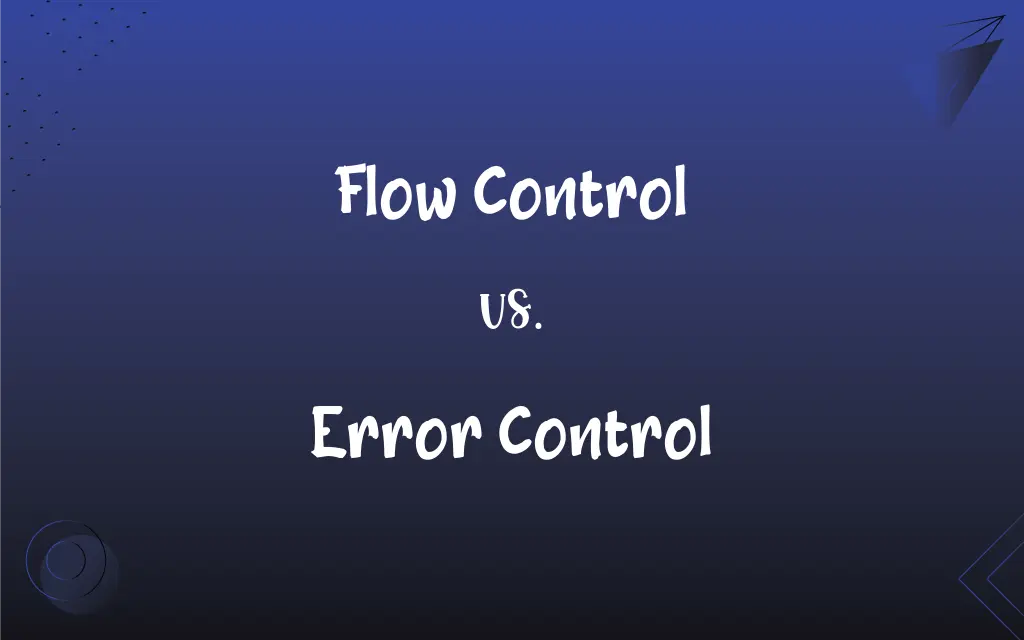Flow Control vs. Error Control: What's the Difference?
Edited by Janet White || By Harlon Moss || Updated on October 11, 2023
Flow control manages data transmission between devices ensuring no data overflow, while error control manages error detection and correction during data transmission. Both contribute to data integrity and efficient communication.

Key Differences
In the context of computer networks and communication systems, flow control and error control play vital roles but cater to different aspects of data transmission. Flow control is fundamentally about managing the rate of data transmission between sender and receiver, ensuring that a fast sender does not overwhelm a slow receiver. It adjusts the flow of data so that the sender’s transmission rate doesn’t exceed the receiver’s processing rate. On the other hand, error control pertains to the mechanisms that detect and correct errors that may occur during data transmission, ensuring that the data received is identical to the data sent.
Moreover, flow control mechanisms use various strategies to prevent buffer overflow, employing techniques like windowing or employing feedback mechanisms from the receiver. These strategies ensure that the sender gets an acknowledgment or a signal to wait before sending more data. In contrast, error control employs algorithms and techniques to either detect or correct errors that have occurred during the transmission of data. Methods might involve parity checks, checksums, or cyclic redundancy checks to validate the integrity of the data.
Delving deeper, flow control is crucial for maintaining the stability and efficiency of a communication system, preventing data loss and ensuring effective utilization of system resources. It involves a balanced and coordinated approach, dynamically adapting to the transmission characteristics and receiver capabilities. Contrarily, error control is all about maintaining the integrity and reliability of data transmission, ensuring that errors arising from factors like noise, interference, or signal degradation are managed effectively through error detection and possible retransmission of data.
Flow control, in ensuring smooth data transfer without overwhelming the receiving system, indirectly aids in preventing error accumulation due to data congestion or bottleneck situations. Conversely, error control, while ensuring that data is received as intended without any alterations or losses, does not regulate the pace or flow of data transmission but ensures accuracy and reliability in the data communication process.
In practical applications, flow control might implement algorithms like sliding window protocols, which manage the number of data packets sent before receiving an acknowledgment. Error control, meanwhile, often deploys error-correcting codes, like Hamming codes, or error-detecting codes, which involve retransmitting data packets that have been identified as erroneous, ensuring reliable data transmission amidst noise and possible disruptions.
ADVERTISEMENT
Comparison Chart
Primary Objective
Manage data transmission rate
Detect and correct transmission errors
Mechanisms
Windowing, feedback from receiver
Parity checks, checksums, CRC
Pertains to
Rate of data transmission
Accuracy and integrity of transmission
Preventative or Corrective
Preventative (avoids overwhelming receiver)
Corrective (fixes occurred errors)
Example Technique
Sliding window protocol
Hamming code
ADVERTISEMENT
Flow Control and Error Control Definitions
Flow Control
Regulation of data transmission speed between sender and receiver.
To prevent data loss, flow control mechanisms were implemented in the network.
Error Control
A mechanism in data transmission for detecting and correcting errors.
Error control ensures that the message received is the same as the message sent.
Flow Control
A method to manage the amount of data transmitted to avoid congestion.
Effective flow control ensures that data is sent at a rate that matches the receiver's processing capabilities.
Error Control
Techniques employed to maintain the integrity of communicated data.
Error control protocols were utilized to ensure accurate data reception amidst network noise.
Flow Control
Techniques ensuring the sender does not overload the receiver with data.
The flow control mechanisms ensured balanced data transmission between devices.
Error Control
Methods used to identify and rectify inaccuracies in transmitted information.
The system utilized error control to rectify the disrupted data packets.
Flow Control
In networking, a mechanism to prevent data packet loss due to overloading.
Implementing flow control allowed for steady and reliable data transfer in the communication system.
Error Control
A facet of communication design aimed at ensuring error detection and correction.
Implementing robust error control minimized the need for data retransmission due to transmission errors.
Flow Control
A strategy in communication systems to prevent buffer overflow.
Flow control halted data transmission to prevent the receiver's buffer from overflowing.
Error Control
Strategies in communication systems for validating and confirming data accuracy.
Through error control, the network ensured all transmitted data was verified for accuracy.
FAQs
Why is error control necessary?
Error control is vital to maintain data integrity and accuracy during transmission.
What is flow control?
Flow control manages the rate of data transmission to prevent overwhelming the receiver.
Why is flow control important?
Flow control is crucial to avoid data loss and ensure efficient utilization of communication resources.
What mechanisms does error control use to detect errors?
Error control employs mechanisms like parity checks, checksums, and cyclic redundancy checks for error detection.
How is feedback managed in flow control?
Feedback, often in the form of acknowledgments, is used in flow control to manage sender transmission rates.
Can error control correct all errors in transmission?
While error control can correct many errors, the efficacy depends on the algorithm and error severity.
Are there various methods of flow control?
Yes, various flow control methods include windowing, congestion avoidance, and rate limiting.
What is error control?
Error control involves detecting and correcting errors during data transmission.
How does flow control prevent data loss?
Flow control regulates data transmission, ensuring the sender does not overload the receiver.
Can flow control be disabled in a communication system?
While possible, disabling flow control can risk data loss and transmission inefficiency.
What happens if error control mechanisms fail?
Failed error control could result in corrupted data being accepted, possibly causing system errors or miscommunications.
Does flow control manage data accuracy?
No, flow control manages data transmission rates, not data accuracy.
How are errors corrected in error control?
Error control often involves retransmitting data or using algorithms to correct detected errors.
Can error control add to data transmission time?
Yes, error control can potentially introduce delays due to error checking and possible retransmission.
Is error control applied in all data transmissions?
While widely utilized, not all systems may employ error control, especially where minor errors are tolerable.
How does error control maintain data integrity?
Error control uses algorithms to detect and correct errors, ensuring transmitted data matches the sent data.
Can error control operate without human intervention?
Yes, error control often operates automatically, detecting and correcting errors during data transmission.
How does flow control handle a slow receiver?
Flow control uses mechanisms like windowing to prevent a fast sender from overwhelming a slow receiver.
Is flow control relevant in all communication systems?
Yes, flow control is universally relevant to prevent data loss and manage transmission rates in communication systems.
Can flow control adapt to various transmission rates?
Yes, flow control dynamically adjusts to manage different data transmission rates effectively.
About Author
Written by
Harlon MossHarlon is a seasoned quality moderator and accomplished content writer for Difference Wiki. An alumnus of the prestigious University of California, he earned his degree in Computer Science. Leveraging his academic background, Harlon brings a meticulous and informed perspective to his work, ensuring content accuracy and excellence.
Edited by
Janet WhiteJanet White has been an esteemed writer and blogger for Difference Wiki. Holding a Master's degree in Science and Medical Journalism from the prestigious Boston University, she has consistently demonstrated her expertise and passion for her field. When she's not immersed in her work, Janet relishes her time exercising, delving into a good book, and cherishing moments with friends and family.
































































